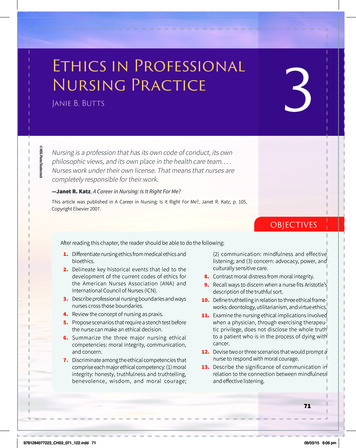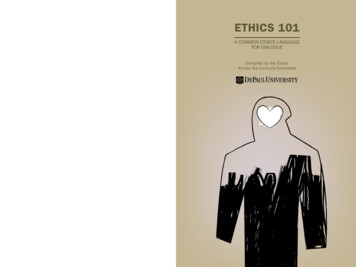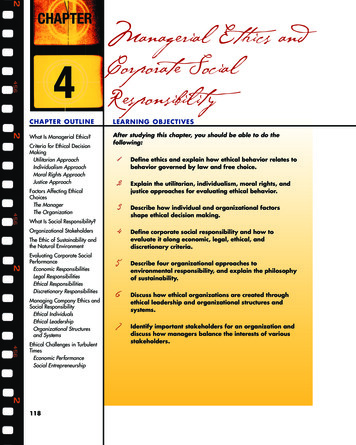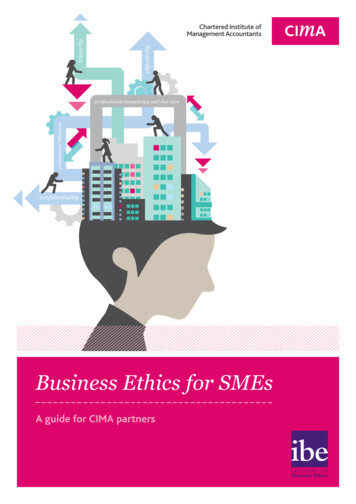
Transcription
ethics in ProfessionalNursing PracticeJanie B. Butts3 WDG Photo/ShutterstockNursing is a profession that has its own code of conduct, its ownphilosophic views, and its own place in the health care team. . . .Nurses work under their own license. That means that nurses arecompletely responsible for their work.—Janet r. Katz, A Career in Nursing: Is It Right For Me?This article was published in A Career in Nursing: Is It Right For Me?, Janet R. Katz, p. 105,Copyright Elsevier 2007.ObjectivesAfter reading this chapter, the reader should be able to do the following:1. Differentiate nursing ethics from medical ethics andbioethics.2. Delineate key historical events that led to thedevelopment of the current codes of ethics forthe American Nurses Association (ANA) andInternational Council of Nurses (ICN).3. Describe professional nursing boundaries and waysnurses cross those boundaries.4. Review the concept of nursing as praxis.5. Propose scenarios that require a stench test beforethe nurse can make an ethical decision.6. Summarize the three major nursing ethicalcompetencies: moral integrity, communication,and concern.7. Discriminate among the ethical competencies thatcomprise each major ethical competency: (1) moralintegrity: honesty, truthfulness and truthtelling,benevolence, wisdom, and moral courage;8.9.10.11.12.13.(2) communication: mindfulness and effectivelistening; and (3) concern: advocacy, power, andculturally sensitive care.Contrast moral distress from moral integrity.Recall ways to discern when a nurse fits Aristotle’sdescription of the truthful sort.Define truthtelling in relation to three ethical frameworks: deontology, utilitarianism, and virtue ethics.Examine the nursing ethical implications involvedwhen a physician, through exercising therapeutic privilege, does not disclose the whole truthto a patient who is in the process of dying withcancer.Devise two or three scenarios that would prompt anurse to respond with moral courage.Describe the significance of communication inrelation to the connection between mindfulnessand effective listening.719781284077223 CH03 071 122.indd 7109/03/15 8:06 pm
72Chapter 3 Ethics in Professional Nursing PracticeObjectives14. Relate patient advocacy and power to nurses’everyday ethical work.15. Formulate an assessment plan for a culturallydiverse patient who is newly admitted to ahospital.16. Characterize two types of relationships:the nurse–physician relationship and thenurse–nurse relationship.17. Explain how nurse recipients of horizontal violence progress to the walking wounded, thentransform to the wounded healer.18. Evaluate nurses’ use of social networking interms of the ANA guidelines for professionalethical conduct.19. Imagine two or three incidents of social mediause in which a nurse violated the ANA Code ofEthics for Nurses with Interpretive Statements.Introduction to Nursing EthicsNursing professionals from the very early years constructed the meaning of nursing around ethics and ethical ways of caring, knowing, and acting. The meaningand scope of nursing ethics expanded as a result of unique nursing issues, but theroad to a greater nursing voice has not been easy. Bioethical issues are relevant tonurses’ work in everyday practice, yet in matters of bioethics nurses are not alwaysautonomous decision makers.During the birth of bioethics from 1947 to the 1970s, nurses’ voices wereleft out of the dialogue of ethics. Complex ethical issues in medicine promptedin-depth medical ethics discourse among physicians, philosophers, and theologians. Pinch (2009) noted thatmainstream ethics was slow to recognize and include the voices of nurses as bothscholars and practitioners who faced innumerable dilemmas in health care . . .[but] this lack of widespread acknowledgement did not mean that the professionof nursing failed to address ethical issues in practice. (pp. 238–239)Nurses began to place emphasis on particular ethical issues that stemmedfrom complicated bioethics, such as pain and suffering, relationships, and advocacy. In fact, nurses led the way in the 1980s in conducting empirical researchon ethical issues (Pinch, 2009). These initiatives strengthened nursing’s role inbioethics.9781284077223 CH03 071 122.indd 7209/03/15 8:06 pm
Introduction to Nursing Ethics73Today nurses in all roles engage in ethical decision making and behaviorsarising from morality, relationships, and conduct issues surrounding patient careand in relationships with each other and other healthcare professionals. Someexperts support the view of nursing ethics as distinctive from bioethics in otherdisciplines (Fry, Veatch, & Taylor, 2011; Holm, 2006; Volker, 2003; Wright &Brajtman, 2011). Additional views indicate everyday ethical practice in nursingas being situated within an interdisciplinary team.Johnstone’s definition of nursing ethics (2008) is consistent with the perception of a strong connection between nursing ethics and nursing theory, whichdistinguishes nursing ethics from other areas of healthcare ethics. Johnstone(2008) defined nursing ethics as “the examination of all kinds of ethical and bioethical issues from the perspective of nursing theory and practice, which, in turn,rest on the agreed core concepts of nursing, namely: person, culture, care, health,healing, environment and nursing itself ” (p. 16).The nursing profession embraces all of the roles that characterize nursing,whether in practice or not. Nursing ethics permeates all of those nursing roles.Nurses’ professional relationships in patient care and within the healthcare teambring about ethical issues that are unique to nursing.Effective praxis in nursing requires nurses make morally good decisions withindistinguishable means and ends to follow through with those decisions; nursing as praxis means ethics is embedded in practice and all activities of nursing.For everyday ethical decision making in work roles, nurses should begin byfirst referring to the Code of Ethics for Nurses with Interpretive Statements as a nonnegotiable guide for ethics (see Appendix B) then branch out for more support, as needed, to other literature and experts on the topic. Taking an e thicalstance is always about justifying the chosen position by backing it up with s upportfrom codes of ethics, moral experts, and the premium and original literature onethical topics; this position is threaded throughout this text. Moral philosophersargue in a highly complex structure in venues, such as in moral philosophy articles or verbally, for and against various issues. As nurses, it is not plausible tocome to a strong justified position about an ethical dilemma or issue withoutsubstantially more in-depth reading and without wide-ranging consideration ofthe historical arguments within the moral philosophy and b ioethical literature.For good ethical decision making through praxis, nurses must be sensitiveenough to recognize when they are facing seemingly obscure or uncomfortableethical issues in everyday work. One such obscurity occurs when a nurse, such asa novice graduate, feels extreme pressure to conform to a hospital administrator’sless than morally desirable decision over an action that would sustain the nurse’sown moral integrity.9781284077223 CH03 071 122.indd 7309/03/15 8:06 pm
74Chapter 3 Ethics in Professional Nursing PracticeResearch Note: Laabs’s Study on New Graduates’ Perceptionsof Moral IntegrityIn 2011 Laabs explored how newly graduated baccalaureate-prepared nurses perceive moral integrityand how prepared they feel to manage challenges.The new graduates described a person with moralintegrity as a person practicing virtue ethics, “actinglike, becoming, and being a certain kind of personwho was honest, trustworthy, consistently doingand standing up for what is right, despite the consequences” but, paradoxically, they also perceivedthe expectations of administrators were for nurses“to set aside their values and beliefs and do whatothers ask, even if this would mean acting contraryto their conscience” (2011, p. 431). These confounding statements form a level of dissonance, whichleads to moral distress and burnout. The ethicalchallenge for new nurses is learning how to maintain moral integrity and preserve mutual respectin an environment that trivializes and discountsnurses’ work as an important contribution to care.Nurses who act contrary to their own values andbeliefs to do what another person asks of themwithout questioning are at risk of becoming morallydesensitized to their own conscience. Some nursesactually begin to think they will never be the kind ofideal, moral nurse they aspired to be.Source: Laabs, C. (2011). Perceptions of moral integrity:Contradictions in need of explanation. Nursing Ethics,18(3), 431–444.Ethical ReflectionKidder (1995) introduced nine checkpoints forethical decision making. In his checkpoint forright versus wrong issues, he provided four waysfor people to test for actions of wrongdoing. Oneway is the intuition test, also known as the stenchtest. Some actions or solutions do not pass anurse’s stench test. Nurses should test the stenchby first asking this question: Does the intendedaction have a smell of moral wrongdoing, suchas something a person feels not quite right, feelswrong or uncomfortable, has an air of corruption,or makes one cringe? If the answer is yes, nursesprobably should not engage in the action. Nurseswill develop a more intense moral sensitivity whenthey regularly practice ways to test for wrongdoingby way of intuition, or the gut.Focus for Debate: Testing for Stench—Should You Set Aside Your Own Beliefsand Values?Form two groups for a live or online classroom.Each group will provide a stance to the following question: Should you set aside your ownbeliefs and moral integrity values to carry out anaction requested by an administrator? Suppose a9781284077223 CH03 071 122.indd 74transporter and an EMT dropped an unconsciouspatient to the floor during a transfer back to thenursing home. Deb, a new registered nurse incharge of this patient’s care, witnessed the incident. A hospital nursing administrator under09/03/15 8:06 pm
Professional Codes of Ethics in Nursingextreme pressure for meeting safety performancebenchmarks asked the nurse not to document thepatient fall or file an incident report.In your opinion, does this request pass thestench test? There are definite safety implicationsin this scenario, but putting aside the legal aspectfor a moment, consider the ethical issues of truthversus deception, truth to self versus loyalty tothe organization, or promoting good versus doing harm. One group will take the side favoring the nursestanding up for what she values as the moral75and right thing to do, no matter what theoutcome is. The next group will take the side of theadministrator.The members of each group will discussthe ethical issues. Spokespersons for each groupwill present and argue the group’s position. Thegroups should constructively argue while discussing the ethical issues arising from the positions.Apply an ethical theory or framework for yourjustification. Get creative with your stance andrationale.Professional Codes of Ethics in NursingProfessional nursing education began in the 1800s in England at Florence Nightingale’s school with a focus on profession-shaping ethical precepts and values. By the end of the 1800s modern nursing had been established, and ethicswas becoming a discussion topic in nursing. The Nightingale Pledge of 1893was written under the chairmanship of a Detroit nursing school principal, LystraGretter, to establish nursing as an art and a science. Six years later, in 1899, theInternational Council of Nurses (ICN) established its own organization and waslater a pioneer in developing a code of ethics for nurses.At the turn of the 20th century, Isabel Hampton Robb, an American nurseleader, wrote the first book on nursing ethics, titled Nursing Ethics: For Hospital and Private Use (1900/1916). In Robb’s book, the titles of the chapters weredescriptive of the times and moral milieu, such as the chapters titled “TheProbationer,” “Uniform,” “Night-Duty,” and “The Care of the Patient,” whichaddressed nurse–physician, nurse–nurse, and nurse–public relationships.The emphasis in the code was initially on physicians because male physicians usually trained nurses in the Nightingale era. Nurses’ technical trainingand obedience to physicians remained at the forefront of nursing responsibilitiesinto the 1960s. For example, the ICN Code of Ethics for Nurses reflected technical training and obedience to physicians as late as 1965. By 1973 the ICN codeshifted from a focus on obedience to physicians to a focus on patient needs, whereit remains to this day.9781284077223 CH03 071 122.indd 7509/03/15 8:06 pm
76Chapter 3 Ethics in Professional Nursing Practice ANA Code of Ethics for NursesIn 1926 the American Journal of Nursing (AJN) published “A Suggested Code” bythe ANA, but the code was never adopted. In 1940 AJN published “A TentativeCode,” but again it was never adopted (Davis, Fowler, & Aroskar, 2010). TheANA adopted its first official code in 1950. Three more code revisions occurredbefore the creation of the interpretative statements in 1976. The ANA added theword ethics to the publication of the 2001 code. The seventh edition, publishedin 2015, is the latest revision.The ANA outlined nine nonnegotiable provisions, each with interpretivestatements for illustration of detailed narratives for ethical decision making inclinical practice, education, research, administration, and self-development (seeAppendix B for the ANA Code of Ethics for Nurses with Interpretive Statements).Deontology and normative ethics largely serve as the basis for the code. Althoughthey are detailed enough to guide decision making on a wide range of topics, theinterpretive statements are not inclusive enough to predict every single ethicaldecision or action in the process of nurses carrying out their roles. A clear patientfocus in the code obliges nurses to remain attentive and loyal to all patients intheir care, but nurses must also be watchful for ethical issues and conflicts ofinterest that could lead to potentially negative decisions in care and relationshipswith patients. Politics in institutions and cost-cutting strategic plans are amongother negative forces in today’s environment.The ANA (2015) explored a variety of topics in the code: (1) respect forautonomy, (2) relationships, (3) patients’ interests, (4) collaboration, (5) privacy,(6) competent practice, (7) accountability and delegation, (8) self- preservation,(9) environment and moral obligation, (10) contributions to the nursing profession, (11) human rights, and (12) articulation of professional codes byEthical Reflection: Code of Ethics Application In the Code of Ethics for Nurses with Interpretive Statements, the ANA (2015) currently emphasizes theword patient instead of the word client in referring to recipients of nursing care. Do you agree? Pleaseexplain your rationale. Take a few minutes to review the ANA Code of Ethics for Nurses with Interpretive Statements inAppendix B. After reviewing the interpretive statements in the code, create and discuss some random briefethical issues on how nurses justify their actions using the following bioethical principles: autonomy,beneficence, nonmaleficence, and justice.9781284077223 CH03 071 122.indd 7609/03/15 8:06 pm
Professional Codes of Ethics in Nursing77organizations. The interpretative statements illustrate many moral situations. Forexample, Provision 6 illustrates wisdom, honesty, and courage as essential virtuesto produce an image of a morally good nurse. When these virtues are habitually practiced, they promote the values of human dignity, well-being, respect,health, and independence. These values reflect what is important for the nurse personally and for patients. Notable in the code is the reference to moral respectfor all human beings, including the respect of nurses for themselves.Another feature of the code is the emphasis on wholeness of character andpreservation of self-integrity. Wholeness of character relates to nurses’ professionalrelationships with patients and a recognition of the values within the nursingprofession, one’s own authentic moral values, integration of these belief systems,and expressing them appropriately. Personal integrity involves nurses extendingattention and care to their own requisite needs. Many times nurses who do notregard themselves as worthy of care cannot give comprehensive care to others.Recognizing the dignity of oneself and of each patient is essential to providing amorally enhanced level of care. ICN Code of Ethics for NursesIn 1953 the ICN adopted its first code of ethics for nurses (see Appendix C for the2012 ICN Code of Ethics for Nurses). The multiple revisions illustrate the codeis a globally accepted document for ethical practice in nursing. Since 1953 nursesin many countries have adapted the ICN code. The fundamental responsibilitiesof promoting health, preventing illness, restoring health, and alleviating sufferingemanates from the role of nursing. The code serves as an action-based standardof conduct related to four key elements: nurses and people, nurses and practice,nurses and the profession, and nurses and coworkers. Similar to the ANA code,the elements in the ICN code form a deontological, normative ethics frameworkfor nurses to internalize before using it as a guide for nursing conduct in practice,education, research, and leadership. Common Threads Between the ANA and ICN CodesCommon threads exist between the nine provisions of the ANA code (2015) andthe four elements of the ICN code (2012). The codes, which apply to all nursesin all settings and roles, are nonnegotiable ethical nursing standards with a focuson social values, people, relationships, and professional ideals. Both codes sharevalues such as respect, privacy, equality, and advocacy.Nurses should protect the moral space in which patients receive care, andthey should uphold the agreement with patients on an individual and collective basis. Protecting the moral space of patients necessitates nurses provide9781284077223 CH03 071 122.indd 7709/03/15 8:06 pm
78Chapter 3 Ethics in Professional Nursing Practicecompassionate care by endorsing the principles of autonomy, beneficence, nonmaleficence, and justice. Within the codes, nursing responsibilities include promoting and restoring health and preventing illness, but a significant emphasisis alleviating suffering of patients who experience varying degrees of physical,psychological, and spiritual suffering. Professional Boundaries in NursingProfessional ethical codes serve as useful, systematic, normative guidelines fordirecting and shaping behavior. The ANA and ICN codes apply to all nursesregardless of their roles, although no code can provide a complete and absolute setof rules free of conflict and ambiguity, which is a rationale often cited in favor of theuse of virtue ethics as a better approach to ethics (Beauchamp & Childress, 2012).Some people believe that nurses who are without a virtuous character cannot be depended on to act in good or moral ways, even with a professional codeas a guide. In the 30th anniversary issue of the Journal of Advanced Nursing, theeditors reprinted a 1996 article by Esterhuizen (2006) titled “Is the ProfessionalCode Still the Cornerstone of Clinical Nursing Practice?”, and the journalsolicited comments from three contributors for the reprinted article. This information is most relevant today. One respondent, Tschudin (2006), agreed withEsterhuizen that nurses lack opportunities for full autonomy in moral decisionmaking. There is abundant ground for nurses to engage in moral decisions, butthey still do not have enough opportunity to participate. In the current uncertain moral landscape, nurses often wonder about the benefit of codes of ethics.Tschudin’s key message was when virtuous nurses experience full autonomy andaccountability, they have an internal moral compass to guide their practice anddo not necessarily need a code of ethics for guidance.However one perceives the value of codes of ethics for nurses, they still serveas mandates for accountability in all roles of nursing, whether in practice or not.Professional boundaries are limits that protect the space between the nurse’s professional power and the patient’s vulnerabilities. Boundaries facilitate a safe connection because they give each person in the relationship a sense of legitimate control,whether the relationships are between a nurse and a patient, a nurse and a physician,a nurse and an administrator, or a nurse and a nurse. The National Council of StateBoards of Nursing (NCSBN) (2011a) explained the power of a nurse as follows:The power of the nurse comes from the professional position, the access to private knowledge about the patient and the patient’s need for care. Establishingboundaries allows the nurse to control this power differential and allows for asafe interaction to best meet the patient’s needs. (National Council of StateBoards of Nursing [NCSBN], para. 2)The blurring of boundaries between persons in a relationship is often subtle and unrecognizable at first. Even so, two distinct types of departures from9781284077223 CH03 071 122.indd 7809/03/15 8:06 pm
Professional Codes of Ethics in Nursing79professional boundaries occur. The first type of departure is boundary violations,which are actions that do not promote the best interest of another person ina relationship and pose a potential risk, harm, or exploitation to another person in the relationship. Boundary violations widely vary, from misuse of power,betrayal of trust, disrespect, and personal disclosure to more severe forms, suchas sexual misconduct and exploitation. The second type of departure, boundarycrossings, is a lesser and more short-lived type that accidentally or intentionally occurs during normal nursing interventions and will not necessarily happen again. The ANA (2015) included numerous boundary issues in its code ofethics. Social media boundary issues are presented later in this chapter in thesection on social media.The obvious question is how nurses know when they have crossed a professional boundary. In 2003, Maes asked oncology nurses this question. Years later,some of their responses are still relevant for today’s nurses. Maes observed the linein the sand is blurry.In addition to the ethical guidelines in the code of ethics, nurses also mustfollow the board of nursing’s legal regulations and standards for practice in his orher state of residence. Every country has its own code of ethics, and each stateand country has a set of legal rules and regulations for nursing practice. Each stateEthical Reflection: Professional Boundaries and Moral Obligationsfor NursesThe following professional boundaries andmoral obligations for nurses are specified by theANA Code of Ethics for Nurses with InterpretiveStatements (2015).Clinical practice boundaries: Respecting patients’ dignity Right to self-determination Delegating tasks appropriately Practicing good judgment Accepting accountability in practice Alleviating suffering Being attentive to patients’ interests Working within the nurse practice acts andnursing standards of practiceProfessional practice boundaries: Maintaining authenticity in all relationshipswith others, such as nurse–nurse relationships,9781284077223 CH03 071 122.indd 79nurse–physician relationships, nurse–patient relationships, and multidisciplinarycollaboration Addressing and evaluating issues of impairedpractice; fraternizing inappropriately withpatients or others; accepting inappropriategifts from patients and families; confidentialityand privacy violations; and unhealthy, unsafe,illegal, or unethical environmentsSelf-care and self-development boundariesand obligations: Participating in self-care activities tomaintain and promote moral self-respect,professional growth and competence,wholeness of character in nurses’ actions andin relationships with others, and preservationof integrity09/03/15 8:06 pm
80Chapter 3 Ethics in Professional Nursing PracticeEthical Reflection: Professional Boundaries and Moral Obligationsfor Nurses (continued) Advancing knowledge and research throughprofessionalism, practice, education, andadministrative contributions Collaborating with other healthcare profess ionals and the public to promote communityand national and international efforts Promoting healthy practices in the communitythrough political activism or professionalorganizations by addressing unsafe, unethical,or illegal health practices that have thepotential to harm the communitySource: American Nurses Association. (2015). Code ofethics for nurses with interpretive statements. SilverSpring, MD: Author.board of nursing is “responsible for enforcing the nurse practice act to promotesafe and competent care” (NCSBN, 2011c, Introduction). Violations can resultin voluntary surrender, suspension, or revocation of a nurse’s license and prohibition from practice. The boards of nursing function not to protect nurses, butto protect the public and ensure safe and competent patient care. Refer to stateEthical Reflection: How Do Nurses Know When They Have Crosseda Professional Boundary?Maes (2003) interviewed several oncology nurses to ask them how they know when they have crossed aprofessional boundary. Their comments are provided in the following list. All of these nurses discussedthe difficulty of trying not to cross boundaries: Emily Stacy, a hospice nurse, stated, “One danger sign could be when you ‘dump’ your own problemsand stressors on patients or their family members because you feel close to them” (2003, p. 4). Jane Hawksley, a nurse manager, added, “New nurses have not developed their own boundaries yet,this can lead to a slippery slope of sympathy versus empathy, making crossing the line easy to do.Usually the red flag is there . . . [so] be aware of your internal responses, and, if in doubt at all, check itout because these responses are a red flag that need to be understood” (2003, pp. 5–6). Barb Henry, a psychiatric nurse practitioner, provided a description of dumping problems on patients:“My job is to help patients deal with their ‘black clouds.’ On one visit, I was carrying around my own blackcloud and was really focused on it. The patient innocently asked me a question related to the issue, and Iended up sharing my black cloud. . . . The boundary line is difficult to maintain” (2003, pp. 4–5).Source: Maes, S. (2003, August). How do you know when professional boundaries have been crossed? Oncology NursingSociety, 18(8), 3–5.9781284077223 CH03 071 122.indd 8009/03/15 8:06 pm
Ideal Nursing Ethical Competencies81boards of nursing websites for examples of how boundary violations result in thesuspension or revocation of a nurse’s license.Legal suits are less likely to be filed if patients distinguish nurses as caring,compassionate, kind, and respectful (Diemert, 2012). If patients or families filelegal suits of negligence or malpractice in a civil court against a nurse, the plaintiff’slawyer must prove injury or harm to the plaintiff as a result of the nurse’s negligence or malpractice. Negligence is failure of the nurse to give care as a reasonably prudent and careful person would give under similar circumstances. Malpractice is improper or unethical conduct or unreasonable lack of skill by anurse or other professional that results in damages.Ideal Nursing Ethical CompetenciesThe ethical competencies identified in this section tend to be interrelated inmeaning, yet each has a degree of distinctiveness. Together they characterize awell-defined, ideal nurse. This section comprises 13 competencies divided into3 major categories: (1) moral integrity: honesty, truthfulness and truthtelling,Legal Perspective: Categories of Negligence That Lead to Malpractice LawsuitsNurses increasingly are named defendants in malpractice lawsuits. From 1998 to 2001, the number ofpayments for nursing malpractice lawsuits increased from 253 to 413. Even though nursing educatorshave made strides in educating nursing students about legal responsibilities, safe care and actions, andlimitations, Croke (2003) argued there are no signs of a decrease in malpractice suits because of numerousfactors, including the following: (1) delegating too much and inappropriately, (2) discharging patients toosoon, (3) nursing shortages and hospital downsizing, (4) increasing responsibility and autonomy of nurses,and (5) patients being more informed and families having higher expectations for safe care.In an analysis of legal cases between 1995 and 2001, Croke (2003) outlined six categories of nursingnegligence that result in malpractice suits: Failure to follow standards of care Failure to use equipment in a responsible manner Failure to communicate Failure to document Failure to assess and monitor Failure to act as a patient advocateSource: Croke, E. M. (2003). Nurses, negligence, and malpractice: Continuing education. American Journal of Nursing,103(9), 54–63.9781284077223 CH03 071 122.indd 8109/03/15 8:06 pm
82Chapter 3 Ethics in Professional Nursing Practicebenevolence, wisdom, and moral courage; (2) communication: mindfulnessand effective listening; and (3) concern: advocacy, power, and culturally sensi tive care. Moral IntegrityThe foremost ethical competency is moral integrity, a virtue often considered thefiber of all other virtues. Most of the time when people speak of a person’s moralintegrity, they are referring to the quality and wholeness of character, which iswhy some believe moral integrity is necessary to realize full human flourishing.Plante (2004) stated that although no one is mistake free, people with moralintegrity follow a moral compass and usually they do not vary by appeals to actimmorally. A person
healing, environment and nursing itself " (p. 16). The nursing profession embraces all of the roles that characterize nursing, whether in practice or not. Nursing ethics permeates all of those nursing roles. Nurses' professional relationships in patient care and within the healthcare team bring about ethical issues that are unique to nursing.










